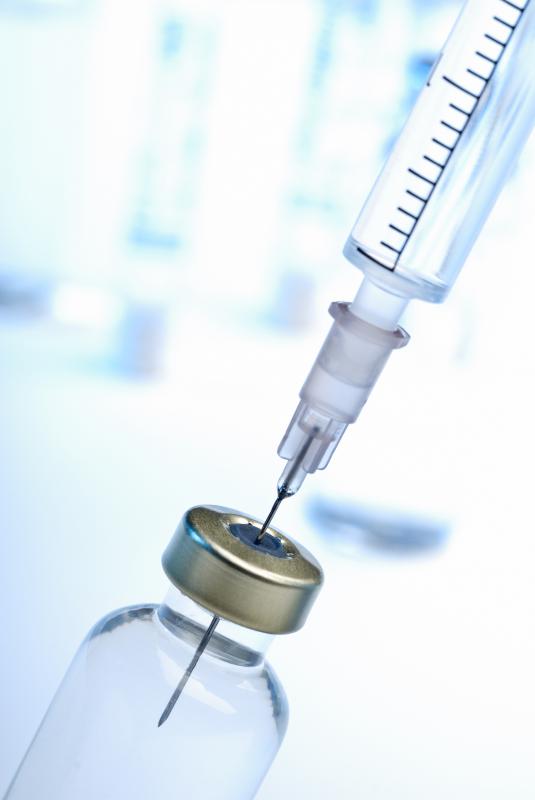At WiseGEEK, we're committed to delivering accurate, trustworthy information. Our expert-authored content is rigorously fact-checked and sourced from credible authorities. Discover how we uphold the highest standards in providing you with reliable knowledge.
What is a Syringe Barrel?
A syringe barrel is the cylindrical part of a syringe that holds fluid to be injected, or fluid that has been withdrawn. The barrel is usually made of glass or plastic. It is often marked with measurements that allow physicians, nurses, or technicians to be sure they are administering the correct dose or drawing enough fluid.
Each syringe has several parts. A plunger draws fluids into and pushes fluids out of the barrel. The hub is connected to the barrel and forms a funnel through which the fluid passes into the needle. A protective cap covers the needle so that it remains sterile, and so that no one is injured by the sharp point.

Needleless syringes propel the fluid out of the syringe barrel, through the hub, and into an open cavity. The most common example is an oral syringe, which may be used to administer medications to children and animals. Other examples are the nasal syringe and the enema syringe. Needleless syringes may also be used to propel medications into an animal's ear.

Syringes that have needles are used to give injections, sometimes known as shots. In these cases, the syringe barrel may hold a vaccine, a liquid vitamin, an antibiotic, a pain reliever, a fertility drug, or another medication. The markings on the barrel are critical to injections because even a small error in dosage of some drugs can have serious consequences.

Needled syringes are also used to draw fluids from the body. The most common example is the drawing of blood, in which a medical professional inserts the needle into a patient's vein and draws it into the syringe barrel. A laboratory will then analyze the blood to look for deficiencies, anomalies, or excesses that may indicate a disease or condition. Medical professionals may also draw spinal fluid, amniotic fluid, or even samples of brain tissue for analysis.

In withdrawals, the markings on the barrel show how much fluid or tissue has been drawn. This is important because the laboratory must have a minimum sample in order to run the proper tests. Drawing another sample wastes time that may be critical to diagnosing and treating the patient. Some fluid and tissue draws are also painful for the patient, so making sure to take an adequate sample helps prevent additional discomfort.
Those outside the medical profession may also use syringes. Scientists use them to take samples, mechanics use them to inject rubber filler into tires, and chefs use them to fill pastries and candies. As a result, a syringe barrel can be used to hold anything from pond water to sealant to raspberry jelly.
AS FEATURED ON:
AS FEATURED ON:














Discuss this Article
Post your comments